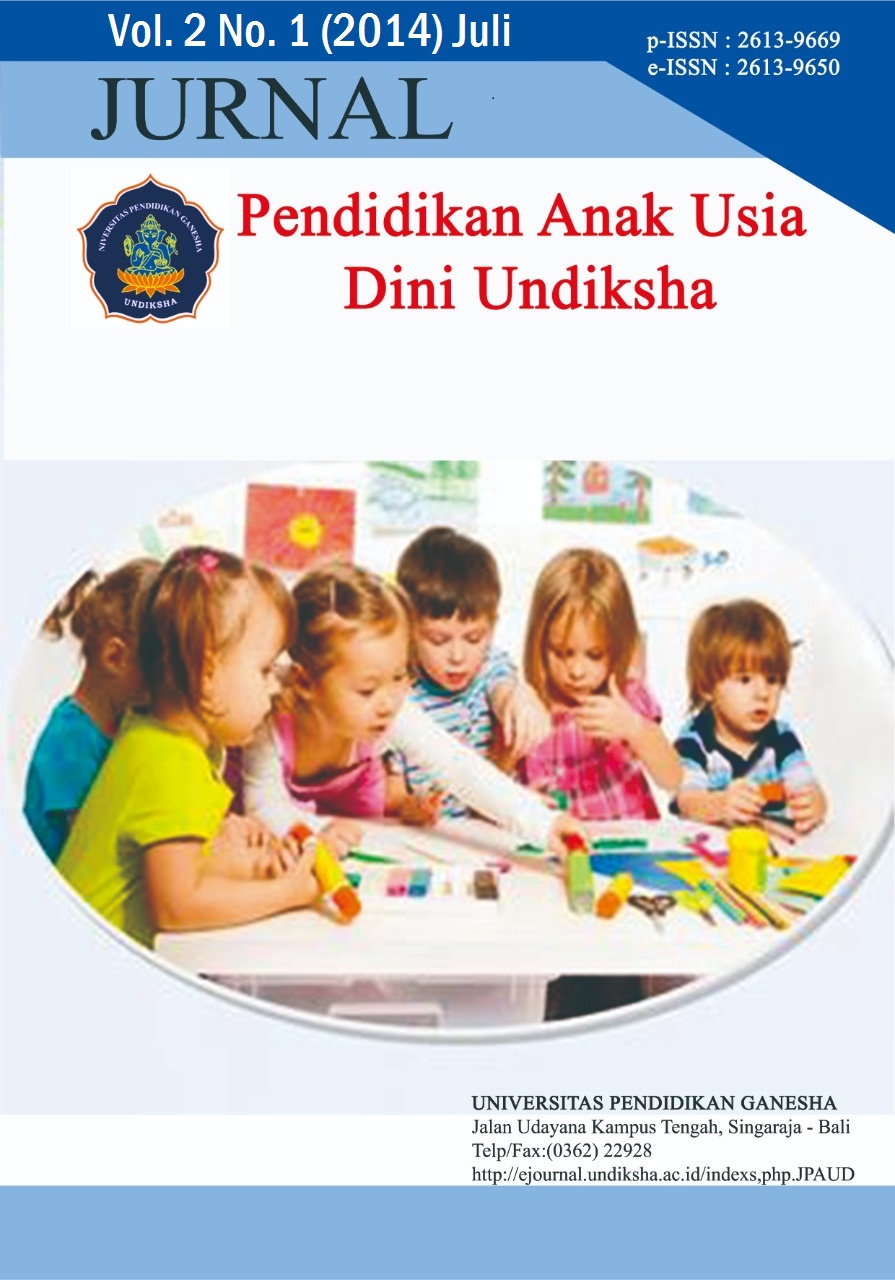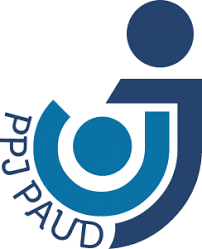PENERAPAN METODE DEMONSTRASI BERBANTUAN MEDIA WADAH TELUR UNTUK MENINGKATKAN PERKEMBANGAN KOGNITIF KONSEP BILANGAN PADA ANAK KELOMPOK B TK DHARMAPATNI DENPASAR
DOI:
https://doi.org/10.23887/paud.v2i1.3168Abstrak
Penelitian ini bertujuan untuk mengetahui peningkatan perkembangan kognitif konsep bilangan melalui penerapan metode demonstrasi berbantuan media wadah telur pada anak kelompok B semester II TK Dharmapatni Denpasar Barat tahun pelajaran 2013/2014. Penelitian ini merupakan Penelitian Tindakan Kelas (PTK) atau Classroom Action Research. Subjek dalam penelitian ini adalah anak kelompok B1 TK Dharmapatni Denpasar Barat tahun pelajaran 2013/2014 sebanyak 18 orang. Data perkembangan kognitif konsep bilangan dikumpulkan dengan menggunakan metode non tes (pengamatan) dengan instrument lembar observasi. Data yang diperoleh dianalisis dengan menggunakan teknik analisis statistik deskriptif kuantitatif. Analisis data dilakukan dengan membandingkan hasil dari siklus I dan siklus II. Pada siklus I diketahui pencapaian perkembangan kognitif sebesar 50,38% dengan kategori sangat rendah. Sedangkan pada siklus II pencapaian perkembangan kognitif sebesar 82,5% dengan kategori tinggi. Dengan demikian dapat disimpulkan bahwa dengan menerapkan metode demonstrasi berbantuan media wadah telur dapat meningkatkan perkembangan kognitif konsep bilangan pada anak kelompok B semester II TK Dharmapatni Denpasar Barat tahun pelajaran 2013/2014.Kata Kunci : metode demonstrasi, media wadah telur, perkembangan kognitif
This study aims to determine the increase in the cognitive development of number concepts of children through the implementation the demonstration method assisted media place of egg on the group B second half of TK Dharmapatni west of Denpasar academic year 2013/2014. This study is an action research or classroom action research. Subjects in this study were children in group B1 TK Dharmapatni west of Denpasar academic year 2013/2014 as much 18 people. The cognitive development of number concepts of data collected using non-test methods (observation) with the instrument sheet of observation. Data obtained in the analysis by using descriptive statistical analysis quantitative. Data analysis is done by comparing the results of the first cycle and second cycle. In the first cycle, if can know the achievement of cognitive development at 50,38% with very low category. While in the second cycle the achievement of cognitive development of 82,5% with high category. It can be concluded that by applying the demonstration method and the media place of egg can improve the cognitive development of number concepts of children group B second half of TK Dharmapatni west of Denpasar academic year 2013/2014.
keyword : demonstration method, media place of egg and cognitive development
Diterbitkan
2014-07-01
Cara Mengutip
., D. F. R. R., ., D. I. W. S. M., & ., D. I. W. W. S. M. (2014). PENERAPAN METODE DEMONSTRASI BERBANTUAN MEDIA WADAH TELUR UNTUK MENINGKATKAN PERKEMBANGAN KOGNITIF KONSEP BILANGAN PADA ANAK KELOMPOK B TK DHARMAPATNI DENPASAR . Jurnal Pendidikan Anak Usia Dini Undiksha, 2(1). https://doi.org/10.23887/paud.v2i1.3168
Terbitan
Bagian
Articles
Lisensi
Authors who publish with the Jurnal Pendidikan Anak Usia Dini Undiksha agree to the following terms:
- Authors retain copyright and grant the journal the right of first publication with the work simultaneously licensed under a Creative Commons Attribution License (CC BY-SA 4.0) that allows others to share the work with an acknowledgment of the work's authorship and initial publication in this journal.
- Authors are able to enter into separate, additional contractual arrangements for the non-exclusive distribution of the journal's published version of the work (e.g., post it to an institutional repository or publish it in a book), with an acknowledgment of its initial publication in this journal.
- Authors are permitted and encouraged to post their work online (e.g., in institutional repositories or on their website) prior to and during the submission process, as it can lead to productive exchanges, as well as earlier and greater citation of published work. (See The Effect of Open Access)











